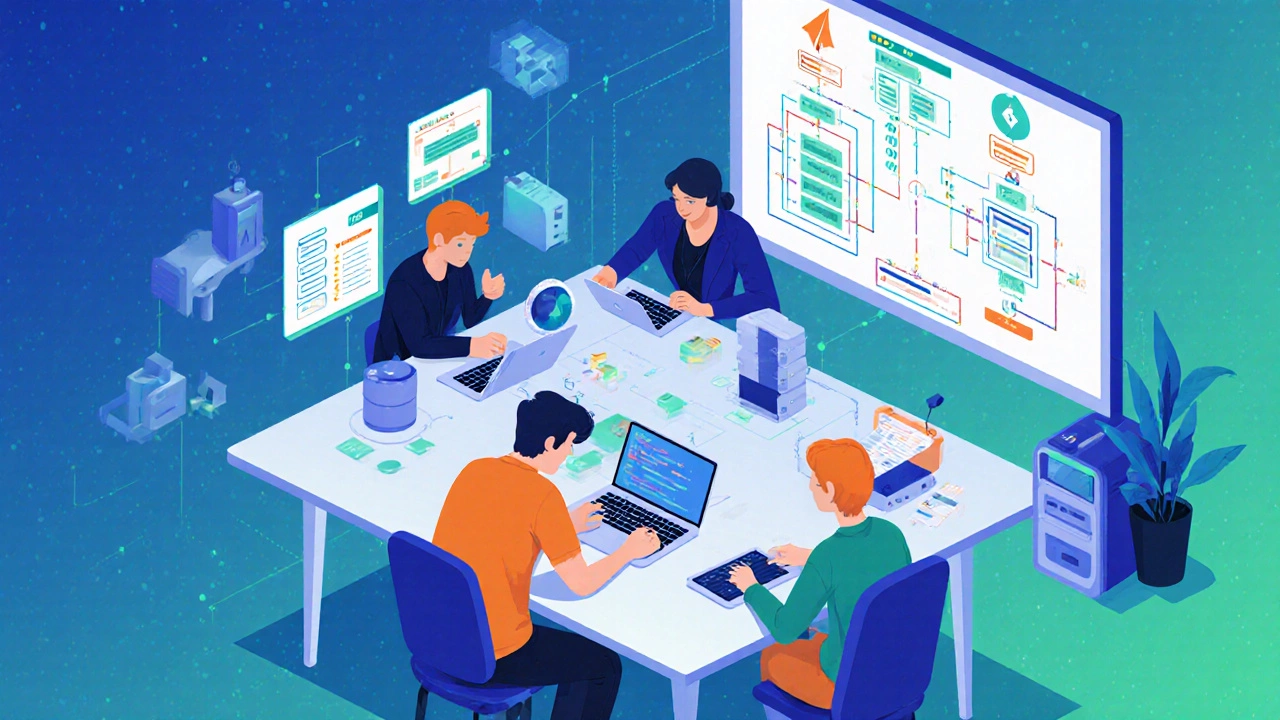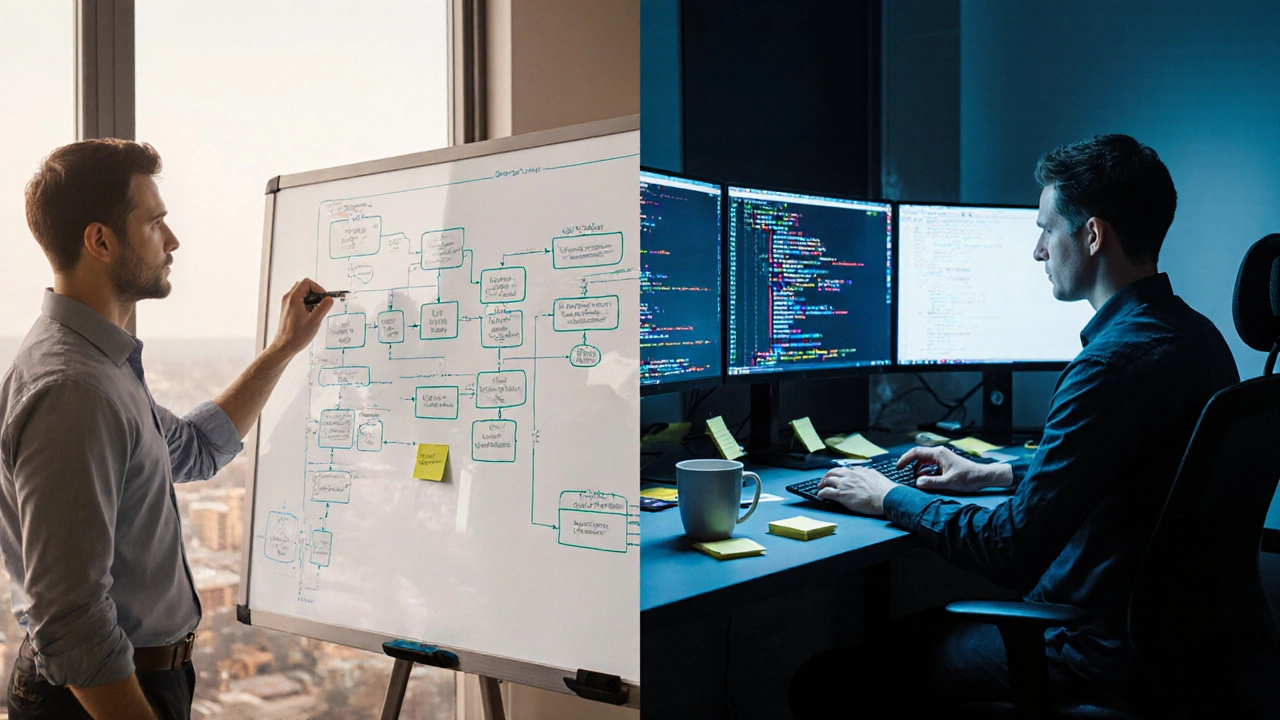Ever heard someone say they "code" and wonder if that’s the same as "programming"? It’s a common mix‑up, especially when you’re just starting out in a coding class. The truth is, while the two terms overlap, they point to different parts of the software‑building journey. This article breaks down the gap between programming and coding, gives real‑world examples, and helps you decide where to focus next.
Quick Takeaways
- Programming is a broader discipline that includes planning, designing algorithms, and managing the whole software lifecycle.
- Coding is the act of writing syntax‑correct statements in a chosen language.
- Programmers think about architecture, scalability, and future maintenance; coders focus on translating logic into code.
- Both roles require problem‑solving, but the scope and responsibility differ.
- Understanding the divide helps you pick the right learning path for your career goals.
Defining the Core Concepts
Programming is the process of designing, writing, testing, and maintaining code to create software applications. It starts with a problem, moves through analysis, design, implementation, testing, and ends with deployment and upkeep. Think of it as the full recipe from idea to finished dish.
Coding is the act of translating algorithms and design specifications into a programming language's syntax. It’s the hands‑on part where you type lines that a computer can execute.
Scope and Level of Abstraction
- Programming works at a higher abstraction level: you decide which modules to build, how they interact, and which design patterns fit the problem.
- Coding sits one level lower: you convert those design decisions into concrete statements like
if (x > 0) { … }ordef add(a, b): return a + b. - In practice, a programmer might sketch a UML diagram, choose a database schema, and outline API contracts before a single line of code is written.
- A coder might receive that diagram and simply implement the functions, ensuring they match the spec.
Typical Tasks and Deliverables
| Aspect | Programming | Coding |
|---|---|---|
| Primary Goal | Design a solution that meets functional and non‑functional requirements. | Write syntactically correct code that implements a given design. |
| Key Activities | Requirement analysis, algorithm design, architecture planning, code review, testing strategy. | Writing functions, fixing syntax errors, using IDE shortcuts, debugging line‑by‑line. |
| Tools Used | UML tools, project management software, version‑control workflows, CI/CD pipelines. | Code editors, compilers/interpreters, linters, debuggers. |
| Typical Output | Design documents, architecture diagrams, test plans, deployment scripts. | Source files (.py, .js, .java, etc.), executable binaries, scripts. |
| Responsibility Level | System‑wide concerns like scalability, security, maintainability. | Local concerns like variable naming, loop efficiency, syntax. |

Real‑World Examples
Imagine a startup building a mobile app for food delivery.
- Programming side: The team decides to use a microservice architecture, drafts API contracts for order handling, selects PostgreSQL for the database, and creates a roadmap for feature releases.
- Coding side: A junior developer takes the API spec and writes the endpoint in Node.js, implements the SQL queries, and fixes bugs reported during unit testing.
Both contributions are essential, but the programmer shapes the overall product, while the coder brings individual pieces to life.
Skill Sets and Learning Paths
If you’re in a coding class and wonder where to aim, consider these skill clusters.
- Algorithmic thinking: Understanding flow, conditionals, and data structures. This is the heart of both programming and coding.
- Design fundamentals: Learning to draw flowcharts, UML diagrams, and decide on modular architectures. This leans toward programming.
- Language fluency: Mastering syntax, libraries, and idioms of a language (Python, JavaScript, Java). This is core coding.
- Tool mastery: Using version control (Git), CI pipelines, and debugging tools. Programmers need a broader view; coders focus on local debugging.
- Testing mindset: Writing unit tests, integration tests, and thinking about edge cases. Both roles benefit, but programmers design test strategies.
Choose a path based on your career goal. Want to become a software architect? Prioritize design, system thinking, and project planning. Aim for a front‑end developer role? Focus on coding, language specifics, and UI libraries.
Common Misconceptions
- "If I can code, I’m a programmer." Not always. Coding shows you can write instructions; programming requires you to plan, evaluate trade‑offs, and maintain the whole system.
- "Programming is just fancy coding." It’s more than syntax; it includes problem formulation, architecture, and long‑term maintenance.
- "Coding doesn’t need any theory." Even line‑by‑line work benefits from algorithmic knowledge and understanding of complexity.
Tips to Bridge the Gap
- Start each coding exercise by writing a short design note: what functions you’ll need, their inputs/outputs, and how they fit together.
- Learn one “big picture” framework (e.g., Django for web apps) and explore how its components interact.
- Pair program with a more experienced teammate. Notice how they discuss architecture before typing.
- Read code reviews. They often highlight the difference between "this works" and "this is a good design".
- Practice translating plain‑English requirements into flowcharts before writing any code.
Frequently Asked Questions
Is coding a subset of programming?
Yes. Coding focuses on writing source code, while programming encompasses coding plus planning, design, testing, and maintenance.
Can someone be a good coder but a poor programmer?
Absolutely. Many developers can write clean syntax but struggle with system architecture, scalability, or long‑term code health.
Do programming jobs require learning multiple languages?
Most programming roles need at least two languages: one for core development (e.g., Java) and another for scripting or automation (e.g., Python). The exact mix depends on the project.
Is there a certification that separates programmers from coders?
Certifications like "Software Engineering Professional" assess design and architecture knowledge, while "Coding Bootcamps" often focus on language syntax and building small projects.
How does testing fit into programming vs coding?
Testing is a programming activity when you design test strategies, write integration tests, and set up CI pipelines. Writing unit tests for a single function is a coding task.
Wrapping It Up
Understanding the difference between programming and coding helps you set realistic expectations for your learning journey. If you aim to design whole systems, dive deeper into architecture, algorithms, and project planning. If you just want to build quick scripts or front‑end features, focus on mastering the syntax, libraries, and debugging tools.
Either way, the two skills reinforce each other-strong coding makes you a better programmer, and solid programming fundamentals make your code more purposeful.
